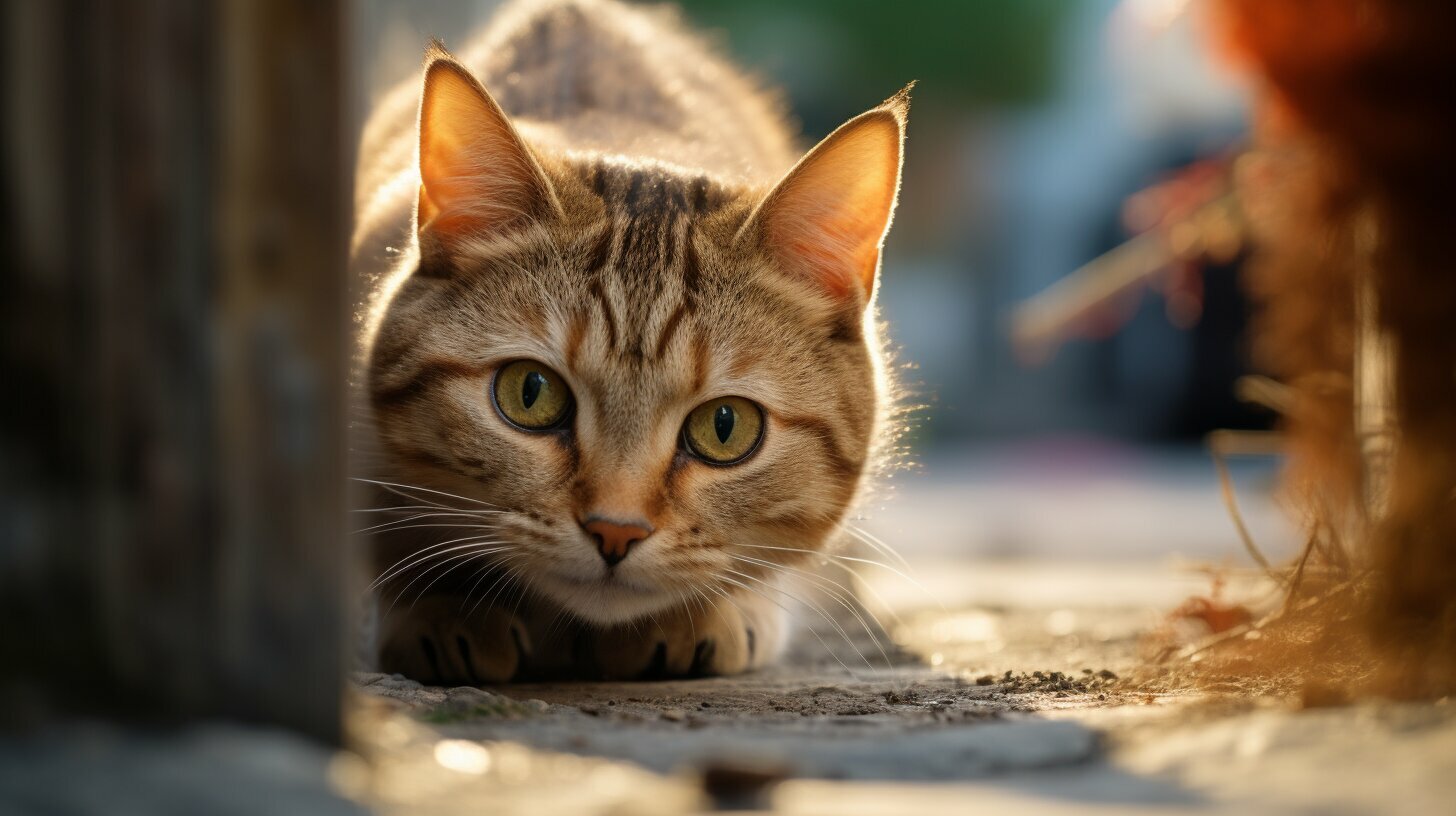Unraveling the Mystery: Why Do Cats Sniff Butts?
If you’ve ever wondered why cats engage in this peculiar behavior, you’re not alone. Cats are known for their curious and sometimes puzzling behaviors, and one that often leaves us scratching our heads is their tendency to sniff each other’s behinds. But fear not, feline enthusiasts, as there is a method to this madness. In fact, butt sniffing plays a vital role in cat behavior and feline communication.
Key Takeaways:
- Cats have a highly developed sense of smell, with 200 million scent receptors.
- Butt sniffing allows cats to gather important information about other cats, such as gender, reproductive status, and emotional state.
- Cats use their anal glands to emit unique scent signals that help establish identity and health.
- Butt sniffing is a way for cats to bond, establish social hierarchies, and mark territories.
- Understanding cat body language, vocalizations, and scent communication is crucial for cat owners to create a comfortable environment for their feline friends.
The Fascinating World of Feline Olfactory Communication
Cats rely heavily on their sense of smell to navigate the world and communicate with their feline companions. With 200 million scent receptors, their olfactory system is far more advanced than that of humans, making scent a crucial aspect of their social interactions. One intriguing behavior that showcases their olfactory communication is butt sniffing.
Cats use butt sniffing as a way to gather important information about other cats. When they approach another feline, they can detect unique scent signals emitted by the anal glands located near the base of the tail. These scent signals contain vital information about the cat’s identity, such as gender, reproductive status, and even emotional state.
By engaging in butt sniffing, cats establish a form of communication that goes beyond vocalizations or body language alone. It allows them to gather a wealth of knowledge about other cats, helping them to build trust, bond with each other, and establish social hierarchies within a group. The exchange of scents during butt sniffing also plays a significant role in marking territories and familiarizing themselves with other cats in their environment.
| Key Points: |
|---|
| Cats rely on their sense of smell for communication. |
| Butt sniffing helps gather information about gender, reproductive status, and emotional state. |
| It is a way for cats to bond, establish social hierarchies, and mark territories. |
Understanding and respecting these unique feline behaviors is essential for cat owners. By recognizing the importance of butt sniffing and other forms of olfactory communication, we can create a comfortable and nurturing environment for our feline friends. This involves accepting their natural behaviors, providing opportunities for scent marking, and ensuring they have ample stimulation to engage their sense of smell in a safe and enriching manner.
The Unique Role of Anal Glands in Feline Communication
The anal glands play a crucial part in feline communication, emitting distinct scents that provide cats with valuable information about each other. These glands, located near the anus, contain a unique blend of chemicals that serve as a form of identification for individual cats. When a cat sniffs another cat’s behind, it is able to detect these scents and gather important details about the other cat’s identity and health.
When a cat sniffs another cat’s anal region, it is not just a casual sniff; it is a deliberate act of communication. By detecting these scent signals, cats can determine the gender, reproductive status, and emotional state of the cat they are investigating. This allows them to gather information about potential mates, rivals, or fellow members of their social group.
The anal gland secretions also play a role in marking territory. When a cat rubs its body against furniture or other objects, it leaves behind a combination of scent from various glandular secretions, including those from the anal glands. This scent marking helps cats establish and maintain their territory, communicating to other cats that this space is claimed. Butt sniffing allows cats to exchange these territorial scents, reinforcing social hierarchies and boundaries within a group of cats.
| Benefits of Butt Sniffing | Role in Feline Communication |
|---|---|
| Allows cats to gather important information about each other | Helps establish social hierarchies and boundaries |
| Aids in identifying potential mates and rivals | Facilitates territorial marking and scent exchange |
| Enables cats to assess the reproductive status and emotional state of other cats | Enhances overall communication and understanding among felines |
Understanding the unique role of anal glands in feline communication can help cat owners better comprehend this curious behavior. It is important to recognize that butt sniffing is a natural and instinctive way for cats to gather information and establish connections with other felines. By respecting and accepting this behavior, cat owners can create a comfortable and nurturing environment for their pets, promoting healthy social interactions and enriching their cats’ lives.
Bonding and Social Hierarchy Through Butt Sniffing
Butt sniffing serves as a vital social interaction for cats, helping them build relationships and establish their position within their social circles. Through this peculiar behavior, cats exchange important information about each other’s gender, reproductive status, and emotional state. It may seem strange to us humans, but for cats, it is an essential part of their communication.
When cats sniff each other’s hindquarters, they are using their highly developed sense of smell to detect unique scent signals emitted by the anal glands. These scent signals contain vital information about a cat’s identity and health. By sniffing another cat’s anal area, they can determine who they are encountering and gather valuable information about them.
Butt sniffing is not just about gathering information; it also plays a significant role in bonding. By exchanging scents, cats are able to build familiarity and trust with one another. This helps them form social bonds and establish a social hierarchy within their group. The scents exchanged during butt sniffing act as a sort of feline handshake, allowing cats to recognize familiar individuals and create a sense of belonging.
As cat owners, it is important to understand and respect these natural feline behaviors. By allowing our cats to engage in butt sniffing and other forms of communication, we are providing them with the opportunity to express themselves and navigate their social interactions. It is also crucial to create a comfortable environment for our feline friends, where they feel safe to engage in these behaviors without judgment or restriction.
| Benefits of Butt Sniffing for Cats |
|---|
| Establishing social hierarchy |
| Building trust and familiarity |
| Gathering important information about other cats |
| Promoting bonding among cats |
By recognizing the significance of butt sniffing and other forms of feline communication, we can enhance our understanding of our cats’ needs and behaviors. This allows us to create a harmonious and nurturing environment for our furry companions, where they feel understood, accepted, and loved.
Marking Territories and Scent Exchange
Butt sniffing allows cats to mark their territories and exchange scents, creating a communal scent profile within their living space. This behavior is an essential part of feline communication and plays a significant role in establishing a cat’s sense of belonging and ownership.
When cats engage in butt sniffing, they leave behind their own unique scent, which acts as a territorial marker. By sharing their scent with other cats in the environment, they effectively communicate their presence and assert their claim over a specific area. This communal scent profile helps cats define boundaries and reduces the likelihood of territorial disputes.
“But sniffing is like a secret handshake among cats, helping them form social bonds and establish a hierarchy within their group.”
In addition to marking territories, butt sniffing allows cats to exchange scents, which is crucial for gathering information about other cats. Through this olfactory communication, cats can determine the gender, reproductive status, and emotional state of their feline counterparts. It serves as a cat’s equivalent of sharing stories and getting to know one another on a deeper level.
Table: Common Cat Scent Marking Behaviors
| Scent Marking Behavior | Description |
|---|---|
| Butt Sniffing | Cats sniff each other’s hindquarters to gather information and establish social bonds. |
| Head Rubbing | Cats rub their faces on objects and people to leave their scent and mark familiar territory. |
| Scratching | Cats scratch surfaces to leave visible and scent markers, claiming territory. |
| Urine Spraying | Cats spray urine on vertical surfaces to mark territory and communicate with other cats. |
In conclusion, butt sniffing is a natural and instinctive behavior in cats that serves as a means of feline communication, marking territories, and exchanging scents. Understanding and accepting this behavior is essential for cat owners as it allows them to create a comfortable and nurturing environment that respects their cat’s natural instincts and needs. So, the next time you catch your cat engaging in a little “sniff and greet,” remember that it’s their way of socializing and expressing themselves in the feline world.
Cat Body Language and Communication Beyond Sniffing
Butt sniffing is just one aspect of a cat’s complex communication repertoire, which also includes body language and vocalizations. Cats use their entire body to express their emotions, needs, and intentions. Understanding these non-verbal cues is essential for cat owners to build a strong bond with their furry friends.
When a cat feels content and relaxed, it may exhibit a variety of positive body language signals. These can include keeping its tail upright, ears facing forward, and eyes half-closed. A relaxed cat may also knead its paws, which is a sign of comfort and contentment. On the other hand, a fearful or anxious cat may flatten its ears against its head, tuck its tail between its legs, and try to make itself appear smaller.
In addition to body language, cats communicate through vocalizations. They may use different types of meows, purrs, hisses, and growls to convey their emotions and needs. For example, a short and high-pitched meow can indicate excitement or a request for attention, while a deep growl can be a clear warning sign. It’s important to pay attention to these vocal cues to better understand what your cat is trying to communicate.
| Body Language | Vocalizations |
|---|---|
| Ears forward: Alert and interested | Purring: Content and relaxed |
| Tail upright: Confident and friendly | Hissing: Fear or aggression |
| Eyes half-closed: Relaxed and trusting | Short meow: Excitement or attention-seeking |
Being able to interpret and respond to your cat’s body language and vocalizations can greatly enhance your relationship with them. It allows you to better meet their needs and provide a nurturing environment. Remember, each cat is unique, so take the time to observe and understand your cat’s individual communication style. With patience and observation, you’ll become fluent in the language of feline communication.
Creating a Comfortable Environment for Your Feline Friend
Providing a safe and comfortable environment for your cat involves understanding and accommodating their natural behaviors, including butt sniffing. Cats rely heavily on their sense of smell to navigate the world and communicate with other cats, so it’s crucial to respect and accept this behavior as part of their feline nature.
One way to create a cat-friendly space is by setting up multiple litter boxes throughout your home. Cats have a strong instinct to mark their territory, and having several litter boxes ensures they have ample opportunities to do so. It also helps reduce any potential litter box conflicts between cats in multi-cat households.
| Tips for creating a cat-friendly environment: |
|---|
| Provide vertical spaces like cat trees, shelves, or window perches, allowing your cat to observe their surroundings from different heights. |
| Offer scratching posts or boards to satisfy your cat’s natural urge to scratch and keep their claws healthy. |
| Ensure your cat has access to hiding spots, such as covered beds or cozy nooks, where they can retreat when they need privacy or feel stressed. |
| Use interactive toys and engage in playtime regularly to keep your cat mentally and physically stimulated. |
Additionally, it’s important to pay attention to your cat’s body language and vocalizations. Cats communicate through various signals, so being able to interpret their cues can help you understand their needs and emotions better. For example, if your cat’s tail is upright and vibrating, it indicates they are content and friendly, while a flicking tail may indicate agitation or aggression.
Remember, every cat is unique, and what works for one may not work for another. Take the time to observe and get to know your cat’s preferences, and adjust their environment accordingly.
Creating a Harmonious Environment for Multi-Cat Households
Living with multiple cats can be rewarding, but it also requires extra attention to ensure each cat feels comfortable and secure. Providing separate resources, such as food and water bowls, litter boxes, and resting areas, can help alleviate potential conflicts and promote a peaceful coexistence.
Regular play sessions and positive reinforcement training can also strengthen the bond between your cats and improve their overall relationship. It’s essential to create an atmosphere that encourages trust, respect, and harmony among all the feline members of your household.
| Tips for a harmonious multi-cat household: |
|---|
| Ensure each cat has their own litter box, plus an extra one, to avoid competition and reduce the likelihood of inappropriate elimination. |
| Offer multiple feeding stations to prevent food guarding behavior and allow each cat to eat peacefully. |
| Provide plenty of vertical spaces and hiding spots so that each cat can have their own territory and retreat when needed. |
| Gradually introduce new cats to the household, using scent swapping techniques and supervised interactions, to allow for a smoother integration process. |
By creating a comfortable environment that caters to your feline friends’ natural behaviors and needs, you can ensure they feel safe and happy in their surroundings. Remember, a content cat is more likely to exhibit positive behaviors and develop a strong and trusting bond with their human companions.
The Importance of Respect and Patience in Cat Ownership
Taking the time to understand and respect your cat’s unique communication style is fundamental in nurturing a fulfilling relationship. Cats have a complex and sophisticated way of expressing themselves, and their body language, vocalizations, and scent communication all play a crucial role in their interactions.
When it comes to understanding cat behavior, it’s important to pay attention to their body language cues. A raised tail indicates a friendly and confident cat, while a swishing tail may indicate agitation or excitement. By observing their posture, ear position, and facial expressions, you can better interpret your cat’s mood and respond accordingly.
In addition to body language, cats rely heavily on scent communication. By sniffing each other’s hindquarters, cats gather vital information about gender, reproductive status, and emotional state. This behavior may seem unusual to us humans, but it is a natural part of feline communication. It’s important to allow your cat to engage in this behavior without interference, as it helps them establish bonds and hierarchies within their social group.
| Tip: | Creating a comfortable environment for your feline friend involves providing vertical spaces, interactive toys, and quiet areas where they can retreat. This allows them to express their natural behaviors and feel secure in their surroundings. |
|---|
Patience is key in building trust and strengthening your relationship with your cat. Give them the time and space they need to adjust to new environments or situations. Avoid forcing interactions or punishing them for exhibiting natural behaviors.
Understanding Cat Body Language
One of the most effective ways to understand your cat’s emotions is by paying attention to their body language. If they are relaxed and content, their body will appear loose and their tail will hang loosely or gently sway. On the other hand, if they are scared or anxious, they may crouch low to the ground with their tail tucked between their legs.
Remember, cats rely heavily on scent communication. By sniffing each other’s hindquarters, cats gather vital information about gender, reproductive status, and emotional state.
- Keep an eye out for these common body language signals:
- – Ears forward and relaxed: This indicates that your cat is attentive and interested in their surroundings.
- – Ears flattened backwards: This is a sign of fear or aggression. Give your cat space and try to identify the source of their discomfort.
- – Purring: While cats often purr when they are content, it can also be a sign of stress or pain. Pay attention to other body language cues to determine their emotional state.
By understanding and respecting your cat’s unique communication style, you can create a harmonious environment where they feel safe and understood. This will help foster a strong bond and ensure a fulfilling relationship for both you and your feline companion.
Conclusion
Butt sniffing may seem peculiar to us, but for cats, it is an integral part of their communication repertoire, allowing them to gather essential information and engage in social bonding. Cats have a highly developed sense of smell, with 200 million scent receptors, which enables them to detect unique scents emitted by the anal glands. Through butt sniffing, cats can determine the gender, reproductive status, and emotional state of other felines.
Not only does butt sniffing serve as a means of communication, but it also helps cats bond with each other and establish a social hierarchy. By recognizing familiar scents and engaging in scent exchange, cats build trust and solidify their place within a group. Additionally, butt sniffing plays a role in marking territories, as cats leave their own scent while familiarizing themselves with the scents of other cats in their environment.
Cats rely on their sense of smell, along with other forms of communication such as body language and vocalizations, to interact with their environment and fellow felines. Understanding and respecting these behaviors is crucial for cat owners to create a comfortable and nurturing environment for their beloved pets. By recognizing the significance of butt sniffing and other curious cat behaviors, we can deepen our bond with our feline friends and ensure their emotional well-being.
FAQ
Why do cats engage in butt sniffing?
Cats engage in butt sniffing as a form of communication and gathering information about other cats. It allows them to determine the gender, reproductive status, and emotional state of other cats.
How do cats use their sense of smell in communication?
Cats have a highly developed sense of smell, with 200 million scent receptors. They use their sense of smell, along with other forms of communication such as body language and vocalizations, to interact with their environment and fellow felines.
What role do anal glands play in feline communication?
Cats can detect unique scent signals emitted by the anal glands when they sniff each other’s behinds. These scent signals contain vital information about the cat’s identity and health.
What purpose does butt sniffing serve in cat bonding and social hierarchy?
Butt sniffing helps cats bond with each other and establish social hierarchies. By sniffing each other’s hindquarters, cats recognize familiar scents, build trust, and determine their place within a group of cats.
How does butt sniffing contribute to marking territories and scent exchange?
Butt sniffing allows cats to mark their territories and engage in scent exchange. By sniffing each other’s hindquarters, cats leave their own scent while familiarizing themselves with the scents of other cats in their environment.
How can understanding cat body language and communication benefit cat owners?
Understanding cat body language, vocalizations, and scent communication helps cat owners better comprehend their cat’s emotions and needs. It promotes effective communication and strengthens the bond between cats and their owners.
How can cat owners create a comfortable environment for their feline friends?
Cat owners can create a comfortable and nurturing environment for their pets by recognizing and accepting natural feline behaviors, such as butt sniffing. This promotes a harmonious relationship between cats and their owners.
Why is respect and patience important in cat ownership?
Respect and patience are crucial in cat ownership when it comes to understanding and interpreting cat behaviors. By learning more about feline communication, cat owners can better meet their cats’ needs and strengthen the bond between them.
- Discovering Why Do Women Wear Lipstick: A Deeper Look - 19/12/2023
- Why Do Golfers Only Wear One Glove? - 16/12/2023
- Why Don’t Hobbits Wear Shoes? - 14/12/2023
Hi, I’m Rhiannon, the lead author behind The News Wire. As a passionate journalist, I strive to bring you the latest news and updates from all over the world. With a keen eye for detail and a dedication to unbiased reporting, I aim to deliver well-researched and informative articles that keep you informed and engaged. From breaking news to in-depth analyses, I cover a wide range of topics with the aim of keeping you in the loop. Join me on The News Wire as we explore the dynamic and ever-changing landscapes of global events, uncovering the stories that matter most.






